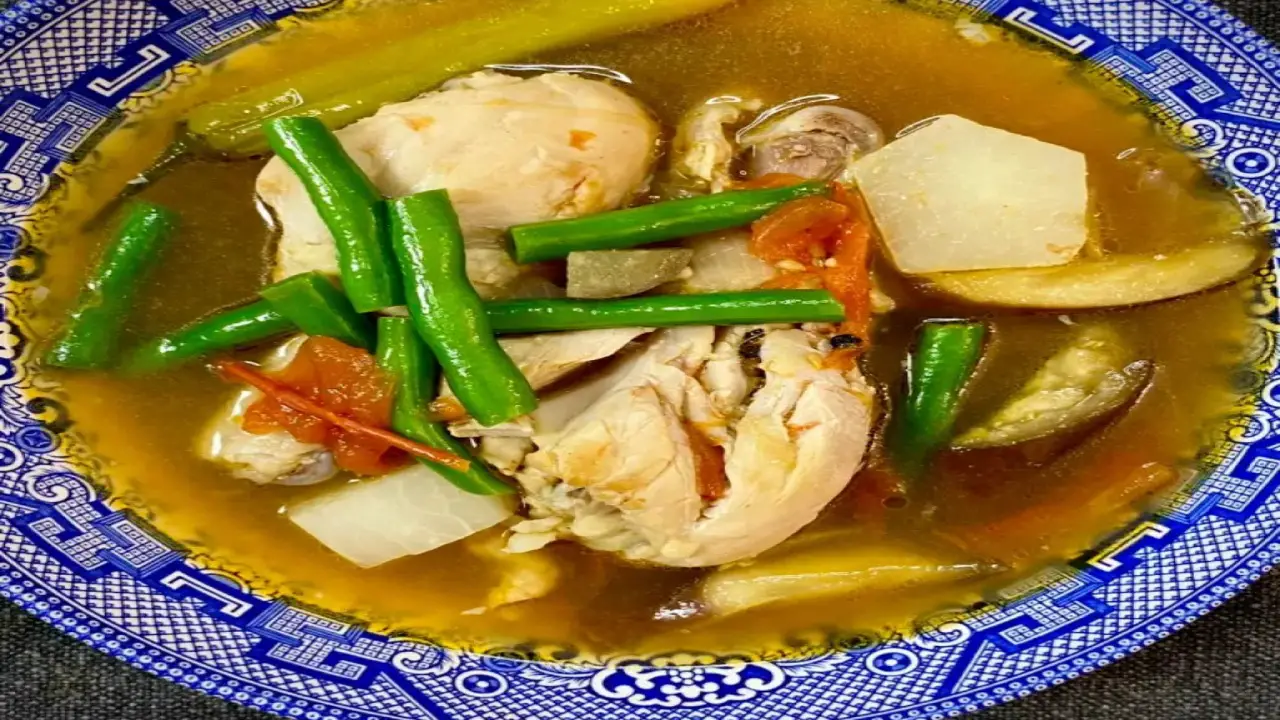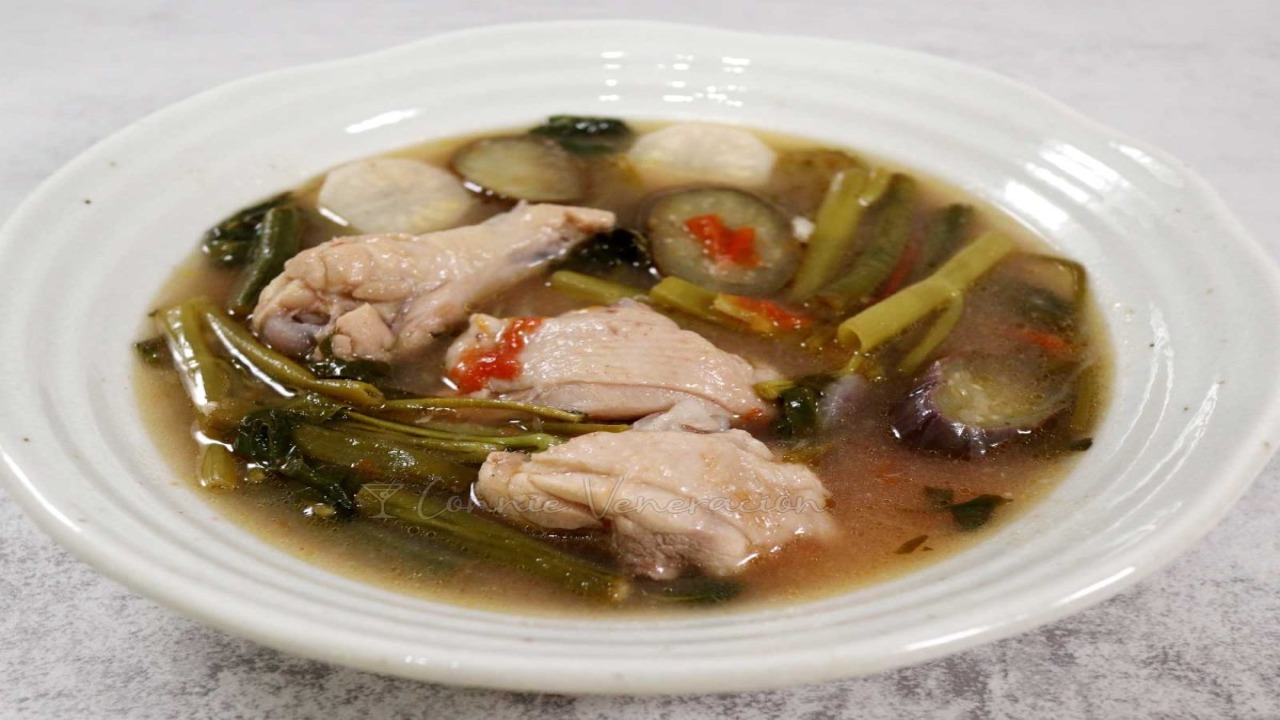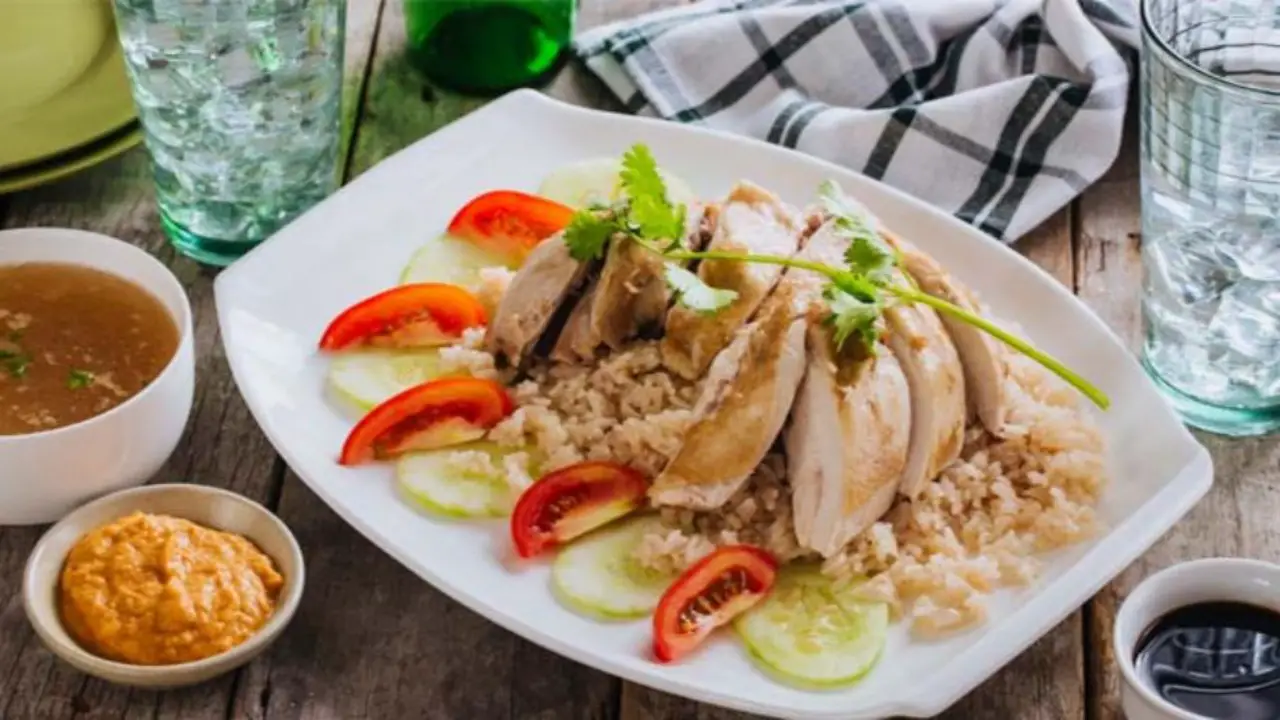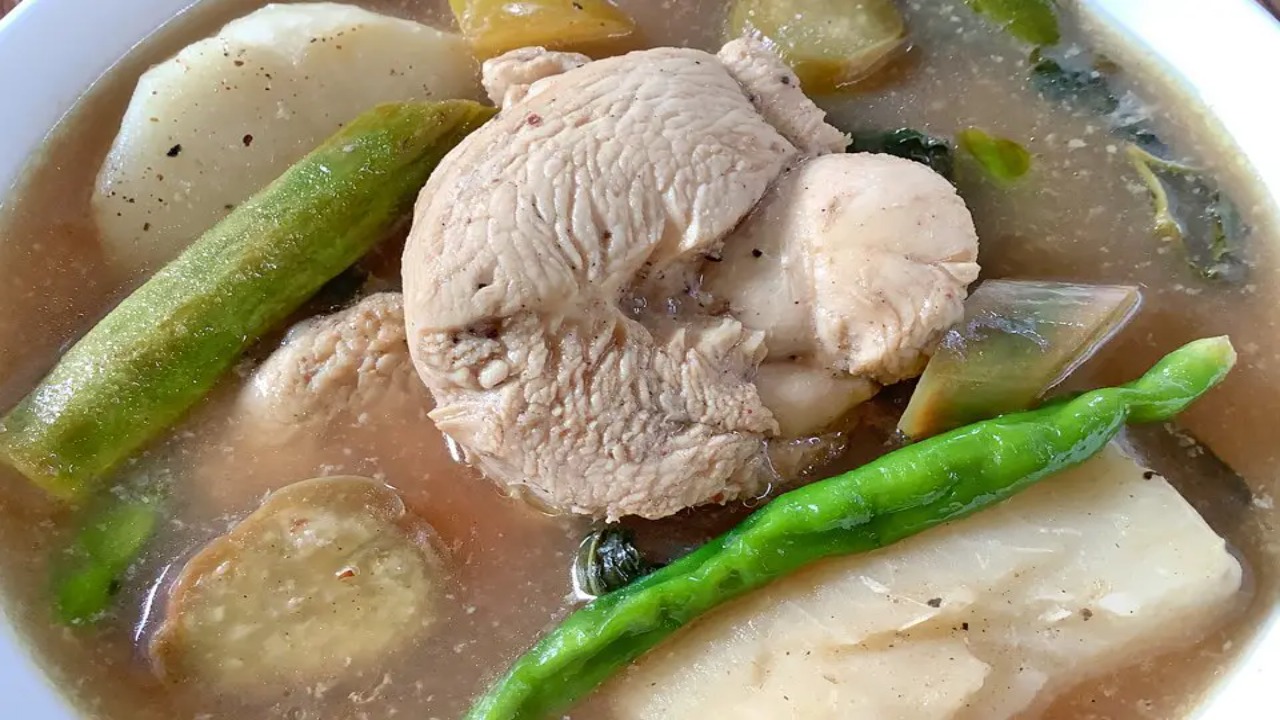Chicken sinigang is a beloved Filipino soup that boasts a unique blend of tangy and savory flavors. The dish features tender chicken, various vegetables, and a flavorful broth infused with tamarind.
It is commonly enjoyed alongside a serving of rice, making it a hearty and satisfying meal. Whether you’re a fan of Filipino cuisine or simply looking to explore new flavors, Chicken-sinigang will surely delight your taste buds with its delectable combination of ingredients.
Here we will take you on a culinary journey as we explore the origins of Sinigang and its unique flavors. We’ll guide you through gathering the necessary ingredients and preparing the chicken for cooking. Get ready to impress your friends and family with this flavorful Filipino delight.

Discovering Chicken Sinigang: A Filipino Delight

Sinigang is a beloved traditional Filipino dish known for its unique blend of sour and savory flavors. The star ingredient in this dish is tamarind, which lends a tangy taste to the broth. While pork and seafood are typical choices for sinigang, chicken can also create a delicious variation.
To prepare sinigang, sauté onions and garlic, then add chicken and vegetables of your choice. Finally, don’t forget to add tamarind to achieve that perfect balance of sourness. Allow it to simmer until the chicken is tender, and you’ll have a delightful and comforting meal that captures the essence of Filipino cuisine. Below we provide full guidelines for making chicken sinigang.
Gathering Your Chicken-Sinigang Ingredients

To create the perfect Chicken-sinigang, you will need a combination of sour ingredients to achieve that distinctive tangy taste. This Filipino dish commonly uses tamarind, tomatoes, and vegetables. You can choose to use fresh sampalok (tamarind) or sinigang mix, depending on your preference and availability.
Along with the sour components, it is important not to forget essential ingredients like onions, garlic, fish sauce, and leafy greens to enhance the flavor profile. Adding radishes, okra, or eggplant can provide extra depth and texture for those who enjoy experimenting with flavors.
Lastly, remember that the choice of chicken parts can greatly impact the richness and texture of your Chicken-sinigang. Whether you prefer using chicken breast for a leaner option or chicken thighs for a more tender result, it’s all about finding the perfect balance of flavors and textures that suit your palate.
Preparing For The Cooking Process

Before diving into the cooking process of sinigang, gathering and preparing all the necessary ingredients is essential. Sinigang is a traditional Filipino soup known for its sour and savory flavors, with tamarind being the key ingredient that gives it that distinct tangy taste.
In addition to tamarind, sinigang typically includes meat (such as chicken or pork), vegetables, and spices. By ensuring that all the ingredients are ready, you’ll be well-prepared to embark on the cooking process and create a delicious pot of sinigang.
Preparing Tamarind Paste And Chicken

To achieve the distinctive tangy and sour flavor of chicken-sinigang, start by soaking tamarind pulp in warm water. Once softened, strain out the seeds and fibers to obtain tamarind paste. This paste will be handy to give the broth its signature taste.
When preparing the sinigang, you can use different cuts of chicken, such as drumsticks or thighs, for added flavor and tenderness. It is recommended to brown the chicken before adding it to the broth to enhance the overall taste. Lastly, the amount of tamarind paste can be adjusted according to your preference for a more or less sour flavor.
Step-By-Step Cooking Instructions
To prepare Chicken-sinigang, start by collecting all the necessary ingredients, such as chicken pieces, vegetables, tamarind soup base, and spices. In a large pot, gently boil the chicken in water until it becomes tender. Then, add the tamarind soup base to infuse the dish with its unique flavors.
Introduce the vegetables, including onions, tomatoes, radishes, and leafy greens, and cook them until they are tender yet still crisp. Finally, season with fish sauce or salt according to your taste preference. Serve this comforting Filipino main course piping hot alongside steamed rice for a satisfying meal.
Exploring Variations And Substitutions In Chicken-Sinigang
Exploring different variations and substitutions in Chicken-sinigang opens up culinary possibilities. From traditional ingredients like tamarind, radish, and fish sauce, to alternative options such as tamarind paste, there are many ways to create this beloved Filipino dish.
Add in your favorite vegetables, proteins, and seasonings to achieve the perfect balance of flavors. Enhance the dish with additional toppings and garnishes, and serve it hot for a satisfying main course. Get creative with new recipes and enjoy the nutritional benefits of sinigang, packed with vitamin C, calcium, and more.
How To Customize Your Chicken-Sinigang?

Customizing your chicken-sinigang is a delightful and creative endeavor. You can experiment with various vegetables to add depth to the dish, such as bok choy, radishes, or okra. Additionally, you can control the level of sourness by adjusting the amount of tamarind paste used or by incorporating other souring agents like kamias or guava.
To enhance the flavor profile further, you can infuse the sinigang with aromatic spices and herbs such as ginger, garlic, and lemongrass. For those who enjoy a spicy kick, incorporating chili peppers or chili sauce can elevate the dish to suit their taste preferences. The possibilities are endless when customizing your chicken-sinigang, allowing you to create a truly personalized culinary experience.
How To Store And Reheat Your Chicken-Sinigang?
To ensure the freshness of leftover chicken-sinigang, it is best to store it in an airtight container and place it in the refrigerator. When reheating the dish, using low heat on the stovetop is important to avoid overcooking.
You can add a splash of water or broth while reheating to maintain the soup’s consistency. Stirring occasionally will help to heat the dish and preserve its flavors evenly. Following these steps, you can enjoy your leftover chicken-sinigang just as deliciously as when it was first prepared.
Tips For Storage And Reheating
To store chicken-sinigang, it is best to transfer it to an airtight container and keep it in the refrigerator for three days. When reheating sinigang, warm it in a pot over medium-low heat. Add water or broth as needed and stir occasionally to ensure even heating. It is advisable to avoid using the microwave as it can affect the integrity of the flavorful broth. Following these steps, you can enjoy your leftover chicken-sinigang while maintaining its delicious taste.
Savouring Your Chicken-Sinigang

To make your sinigang even more delicious, use fresh ingredients such as chicken, vegetables, and tamarind paste. The tamarind paste adds a tangy flavor to the dish, so you can adjust the sourness by adding more or less according to your taste preferences.
It is essential not to overcook the chicken to retain its tenderness. To enhance the flavor and nutritional value of the sinigang, you can add kangkong (water spinach), radish, and eggplant. Serve the sinigang hot with steamed rice for a satisfying meal.
Serving Suggestions For Chicken-Sinigang

I recommend serving a generous portion of fluffy rice to elevate your chicken-sinigang dining experience. Garnish the dish with fresh cilantro or chopped scallions for added flavor and visual appeal. For a spicy kick, include chili peppers or drizzle chili oil over the sinigang.
To enhance the overall taste profile, squeeze calamansi or lime juice over the dish before serving. Complement this flavorful main course with a refreshing cold beverage such as iced tea or citrus-infused water to cleanse the palate and balance out the richness of the sinigang flavors.
Conclusion
Chicken sinigang is a flavorful and comforting Filipino dish that can be easily made at home. The key to cooking the perfect Chicken-sinigang lies in gathering fresh ingredients and following step-by-step cooking instructions. You can also customize your Chicken-sinigang by adding your favorite vegetables or adjusting the level of sourness to suit your taste.
Store any leftovers properly and reheat them for a delicious meal later on. Chicken-sinigang is a standout dish that showcases the unique flavors of Filipino cuisine. If you enjoy Chicken-sinigang, you may also want to explore other Filipino recipes with similar delightful flavors.
Frequently Asked Questions
1.Is Filipino Sinigang Healthy?
Ans: Filipino sinigang can be a nutritious dish depending on the ingredients used. Traditional sinigang includes vegetables like kangkong, radishes, and tomatoes packed with nutrients. To make it healthier, choose lean proteins like chicken or fish and use low-sodium broth.
2.What Does Sinigang Mean In Tagalog?
Ans: In Tagalog, “sinigang” refers to a cooking method involving a souring agent. Filipinos know Sinigang as a popular dish that has a sour broth achieved by adding tamarind, guava, or other fruits. People commonly make it with pork, beef, shrimp, or fish.
3.What Is Special About Sinigang?
Ans: Sinigang is a beloved Filipino soup that stands out for its tangy and savory flavors. The key ingredient, tamarind, gives it a distinct sour taste. Whether made with pork, beef, or seafood, sinigang is always loaded with various vegetables like radishes, spinach, tomatoes, and green beans.
4.What Is Known As Sinigang?
Ans: Sinigang is a popular Filipino sour soup dish made with tamarind as the souring agent. It is popular for its tangy and savory flavors, often cooked with meat and vegetables. Other souring agents like guava or calamari can also be used. Enjoy sinigang with steamed rice as a comforting meal.
5.What Is Sinigang And Why Is It Good For You?
Ans: Sinigang is a traditional Filipino soup with meat, veggies, and tamarind broth. Packed with antioxidants and vitamins, tamarind offers numerous health benefits. Sinigang is low in calories yet rich in nutrients from vegetables and protein from meat. Its sour taste stimulates appetite and aids digestion.